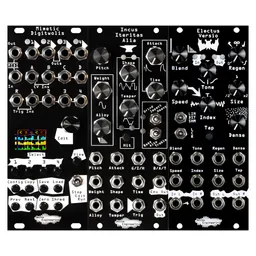We’ve discussed a few ways to modify CV signals using things like attenuators, offsets, and slew. Today, we’ll be chatting about one of the final, and more unusual, CV modification techniques, called rectification.
What is a rectifier?
A rectifier is a simple utility that takes in a bipolar signal and outputs a modified version of that signal that is unipolar.
There are two types of rectifiers: half-wave and full-wave rectifiers.
Positive half-wave rectifiers only allow through the portion of the signal that is above 0 volts, and any signal below 0 volts is clipped to 0. Negative half-wave rectifiers function the same way, but instead clip signals above 0 volts.

A sine wave (top) run through positive (middle) and negative (bottom) half-wave rectifiers
Full-wave rectifiers do a bit more: instead of just clipping signals that are below 0 volts, they invert them: this means that a full version of the input waveform is still output, but it is entirely positive.

A sine wave (top) run through positive (middle) and negative (bottom) full-wave rectifiers
Uses in patching
Rectifiers are quite simple modules: generally they will only have inputs and outputs and no parameters. They’re quite handy when patching with modules that have CV inputs that only respond to positive signals, like many of our oscillators, and most VCAs. Here's an example using a -5V to +5V LFO to modulate a 0V to +5V CV input: the first example is the unrectified LFO, and the second example uses a full-wave rectifier to utilize the full LFO output.
Rectifiers are also built into some other utilities like envelope followers. By running an audio signal through a positive full-wave rectifier and then a slew, the envelope of an audio signal is generated as CV. Without rectification, the generated envelope could end up being negative, and would be less smooth.

A kick pattern (top) run through a full-wave rectifier (middle) and a slew to create an envelope signal (bottom)
Rectifiers can also be used as an audio effect. They’re the basis for some octave fuzz guitar pedals, and they’re also used in a few synth modules like our Pura Ruina and the Serge Wave Multipliers. Rectifiers used for audio effects also tend to have more controls than their utilitarian counterparts.
When implemented in audio circuits, rectification is generally undone at the output as the signal is AC coupled, which makes it bipolar again, which means you won’t be able to use audio-focused rectifier effects for CV processing.
However, if you have a rectification utility, it can be used as a simple, static effect for audio processing; you’ll have no control over the new timbre it creates, but it can yield interesting results.
Suggested modules
ADDAC208: A set of four rectifiers (positive and negative full- and half-wave rectifiers) and a comparator.
Noise Engineering Pura Ruina: An audio effect that uses three stages of full-wave rectification to change the timbre of sound.







